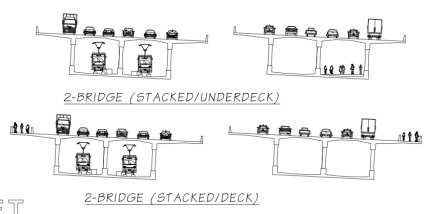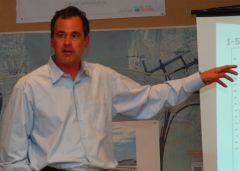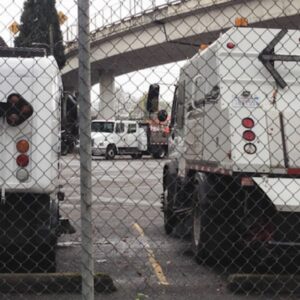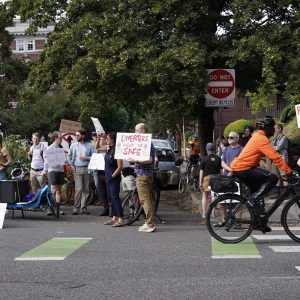
The Pedestrian and Bicycle Advisory Committee (PBAC) for the Columbia River Crossing (CRC) is scheduled to make an official recommendation about the bike/ped facility component of the project at their meeting in Vancouver today.
CRC project staff hope for a consensus on one of two, two-bridge, “stacked” options that remain on the table. The two options boil down to putting bicycle and pedestrian traffic on an upper deck, adjacent to motor vehicle traffic or putting it underneath.
Nearly all of the analysis and expert opinion at this point seems to favor the underdeck option, but there is also a growing discomfort among bike advocates that neither option is acceptable and — despite urging from CRC staff that consensus is needed — a growing stalemate exists.
Back in June, it seemed that the underdeck design, coupled with strong commitments on maintenance and security, would move forward as the clear winner. However, now it seems like there are just too many “ifs” in that approach. What if the promises aren’t kept? What if maintenance/security measures are value-engineered out of the project? What if there is no authority to enforce such a commitment?
The Bicycle Transportation Alliance, who has sat on the CRC’s ped and bike committee for years, has expressed concerns about an underdeck facility since June. The BTA’s Michelle Poyourow said she feared such a facility would be “underused” due to users who would “feel alone”.
However, back in July, Poyourow said they would support the underdeck option if a strongly worded security and maintenance agreement would be signed by appropriate agencies on both sides of the river. But since then, Poyourow and the BTA have hardened their opposition to the bridge.
Last week, after The Oregonian published an editorial that seemed to call into question any spending on bike/ped facilities, two members of the BTA board issued a response (it has not yet been published) that included their strongest opposition to the project yet:
“This CRC proposal, if it were ever to get built, would be a $4 billion mistake… the seven-mile project corridor lacks consistent bike-able paths and roadways, making this is a bike bridge to nowhere for cyclists.”

Portland Bicycle Advisory Committee
meeting in May.
(Photo © J. Maus)
David Parisi, who is heading up the CRC’s bike and pedestrian design process, took both bridge design options to the City of Portland’s Bicycle Advisory Commitee (BAC) and its Pedestrian Advisory Committee (PAC)* earlier this month.
At the City’s BAC meeting, members elected to not recommend either option (much to the chagrin of Parisi). As committee members and the CRC project representative on the city committee, Shayna Rehberg, tried to organize a vote, committee member Ian Stude shared that he was not comfortable with either option. “What if we don’t make a recommendation at all?” he wondered.
As talks of a vote broke down, Parisi threatened the group that funding for the bike/ped facility could be in jeapordy if consensus on one of the two options was not made. In the end, the City’s BAC decided to not make a recommendation. According to committee Chair Matt Arnold, they intend to draft a position letter on the project to Mayor Adams expressing their concerns.
The City of Portland’s BAC is unlikely to outright oppose the project and remove themselves from their advisory role, but the BTA is in a different position. They are caught in an increasingly difficult advocacy situation.
The BTA is clearly not in support of the project, but as standing members of the CRC bike/ped advisory committee, they have devoted hundreds of staff hours to helping CRC staff design the bridge. How can they justify supporting the project in an advisory role (especially when they have limited staff capacity), while at the same time they are calling it a “mistake” and a “bridge to nowhere for cyclists”?
We’ll have more on this after today’s meeting.
For more on the Columbia River Crossing, view our previous coverage.
*The City of Portland Pedestrian Advisory Committee has officially recommended the underdeck option with the condition of commitments on a maintenance and security agreement.






Thanks for reading.
BikePortland has served this community with independent community journalism since 2005. We rely on subscriptions from readers like you to survive. Your financial support is vital in keeping this valuable resource alive and well.
Please subscribe today to strengthen and expand our work.
it seems to me that one can have a preference for the underdeck option while still bashing the bridge! clearly MAX/bike bridge > no bridge > underdeck > ondeck. is this not an option?
any chance we can get the 4B$ to stay in the region and build out a couple more max lines like we did with the Mt Hood Freeway?
any chance we can get the 4B$ to stay in the region and build out a couple more max lines like we did with the Mt Hood Freeway?
No. Federal law used to allow highway funds to be transferred to transit projects, but not anymore. Each has a dedicated funding stream now.
I prefer any bike plan that doesn’t involve the underdeck rape/assault corridor.
If we do have to sink our budget with this massive bridge I’d like the pedestrians and cyclists to have more space and be on the top for security, the view, and to show the drivers in traffic that they could live better by changing their mode of transportation.
Chris-
How do you how that it won’t be letting the Bikers know that they could be cruising along at 75 mph instead of going 15? at least right when the bridge opens it’ll be an “improvement” in congestion. this change of mode thing goes both ways
No public subsidies for SOV drivers in SW WA.
Just for the love of God dont put us in the dizzying and horribly loud center of the bridge like the 205. It feels semi-safe, but I get a vertigo-like disorientation do to 75mph traffic going both ways. And I dont like the proposed idea of the mugging corridor under the bridge. It would be ideal to be on the top, and maybe have some kind of slight covering. Wasnt this project supposed to feature “world class” bike and ped facilities? Oh wait that was before it was value engineered. Well if we cant afford to do it right, maybe we shouldnt do it at all.
I think I need to get to making some ‘KILL THE CRC’ t-shirts.
Why would anyone ever want to drive to work? (not really sarcastic though I know a number of you will go off on why you still need cars) I have my car for driving to Yakima to see my girlfriend while she’s in med school. For everything else there’s a Burley trailer, rubbermaid tubs and bungee cords! Driving Makes Us Angry
For comparison, Seattle’s Mount Baker Ridge Tunnel for I-90 includes a bike/pedestrian tunnel. It’s not as long as the CRC bike/ped proposal (I think) but it’s still pretty long and and a similar highway traffic corridor. It’s well-lit with enough room for two-way traffic, and I wasn’t uncomfortable riding through it. I wonder how it’s worked out for others, and what safety studies available for it? I found a PDF document by Rails-to-Trails Conservancy, 2001, which sounds like it’s been quite safe (Case Study C). The section “Impacts on Adjacent Communities” and Figure 5 in that doc also suggest to me that safety concerns in advance were higher than actual problems warranted.
My own riding preference is on top of the bridge, where I can see the sights, on both outside edges. The Glenn Jackson’s center bike/ped lane is markedly unaesthetic to ride, with poor views and motor traffic on both sides, as well as a bit too narrow to accommodate two-way traffic of both bikes and peds.
Can any civil engineer chime in here with a reason why a whole separate bridge for peds and bike is not feasable? Could it possibly cost more than $10 mil to get from OR to WA? And it has the advantage of allowing realignment farther west (i.e. from Jantzen Beach to Ester Short park)
I hate the I-205 bridge because of noise, air pollution, and blowing sand. Either option has its drawbacks, but I prefer the under-bridge. They estimate an additional 100 million dollars to put bikes on top due to wider bridge decks, and longer approach ramps.
One more reason to stop this project… During the meeting The CRC’s David Parisi, threatened the committ they they don’t really need a bike/ped path. Jonathan, I’m sure you know what I’m talking about. Did you happen to record what he said???
In addition to T-shirts, some lawn signs would be great to see.
The under-deck option requires “strong commitments” to maintenance and safety standards from both sides. Assuming Portland and Vancouver will be sharing the cost– what happens when Vancouver leadership or voters (who’ve vehemently opposed things like light rail in the past) decide not to uphold their end of the bargain? Would such a situation ever result in the bike / ped facilities being closed due to political gridlock?
Allan @ 10
As a matter of fact the Mt Baker tunnel is a regular part of my commute as is the I-90 floating bridge bike / pedestrian lane – which is probably pretty analogous to the on-deck option above. There have in fact been a couple cyclist muggings in the tunnel – though generally it’s pleasant – more temperate, dry and quiet.
After a few years I’ve learned to tune out the noise / grit in summer and drenching mist whipped up by motor traffic the rest of the year on the bridge deck and focus on the view of the lake.
The 10 foot lane is nearly wide enough (there was discussion of narrowing it – that would be a horror show the first time a group of racer-Joe club cyclists tried to overtake a wobbly family outing.)
As for all the drivers on their way to work, sometimes I’m passing them, more often they’re passing me, but that never makes me think I should be driving too.
JAT in Seattle @ 15:
Thanks for commenting! Regarding the I-90 bike/ped lane width, yes, I agree it’s barely wide enough. I’ve been buzzed unpleasantly close–I felt dangerously close–by racer packs on that stretch once or twice, but generally found it a nice crossing with great views.
At your suggestion, I tracked down two distinct muggings in the Mt Baker tunnel (pub. dates):
o May 16, 2008
o March 3, 2009
Also, a neighbor to that area commented about those muggings: “There were quite a number of them (5 or 6 – probably a dozen or more attempts) spread out over a about a year.” Posting this past July, s/he goes on to say “I think the muggers may have been scared away by the publicity.” Another poster suggests waiting at a safe location to team up with other riders for safer group passage.
Anyway, I appreciate the info on actual experiences in a similar situation. Facts improve a discussion. 🙂
For a preview of your under-deck experience, stand under I405 at rush hour. Booming trucks and slapping expansion plates. But Don’t worry, none of this will get built. There is just not the money in Clark County to ram this through (politically). And let us be honest, the bridge is mainly benefiting that constituency. If there is a bridge it will be in 8 years after the I-5 bridge collapses in an earthquake and will have tolls (for cars). By that time, gas will be $5 per gallon.
Covered (from rain, heat) exclusive bike lane away from traffic sounds like the perfect option. Probably no less safe then the springwater trail at night.
Sounds like a below deck option makes sense not sure why all the debate.
kitty:
If gas is $5 a gallon eight years from now, it’ll mean the Right Wing had their coup against democracy, and the oil companies got their way. If today we had $5 gas, it would still be underpriced relative to most of the world.
We currently have the lowest gas tax in all of the industrialized world, and it’s been considered politically off-limits to even discuss raising it. The tax won’t matter much, though, because the price should go up pretty rapidly as oil fields hit their limits, and mid-east turmoil keeps going apace.
What makes everyone think that having a top deck bike trail will prevent muggings? Back in 1999 I was, dare I say accosted, on the I-5 bridge by a drunken homeless man who stopped me because he didn’t think I belonged there. He threatened to shoot me next time he saw me and had his gun with him. I managed to get by him because he was almost too drunk to stand upright. So I didn’t take it too seriously at the time.
My point is that drunks or meth addicts don’t really care where they are or who sees them. They’ll say, or do whatever they need to, or want to do.
the only way to relieve traffic on I-5 is to put more traffic elsewhere. Repair the railroad bridge and if necessary add a 3rd local access bridge. We can do it much cheaper and help encourage the couve to build up, not out.
Based on my experience riding a motorcycle on the lower deck of the Freemont Bridge, I might say the experience wasnt’ too bad, with the exception of the cars presence. It’s design allows a fair amount of natural light to enter the roadway, and it’s nice and breezy.
If there were no cars due to the space being limited to the use of pedestrians and non-motorized vehicles, there’d be the noise other people have talked about in regards to an underdeck option for the CRC.
Who, that is involved with the design details of the CRC might have some solid information about how much of a factor this noise might be to the experience bike-pedestrian users of an underdeck configuration on the CRC will have?
Despite the extraordinary anticipated cost of the CRC at this point, it’s very hard not to get the impression that the absence of such information is just one more example of how all considerations besides those necessary to move car and truck traffic across the Columbia River at greater than present volumes…are regarded as worthy of very little consideration if any at all.
With the CRC being as big as it’s going to be, the opportunity is there to create something very innovative and forward thinking. People early on, put forth suggestions to that effect. After all, a deck of this bridge will, in terms of simple square feet, represent a lot of real estate. For the best use of that real estate, I seem to recall people proposing everything from housing, small shops, market stalls, gardens, and of course…the bike and pedestrian paths.
Instead, the proposed design of the CRC has been gradually dumbed down to the point of being little more than a big ugly motor vehicle artery with the inclusion underdeck of a dark, noisy prison-like environment for pedestrians and people on non-motorized vehicles to make their way across this bridge.
The people that stand to make money off this project may succeed in pushing it through. As things stand now, I’ll be very surprised if becomes something that most of the public will be able to regard with pride.